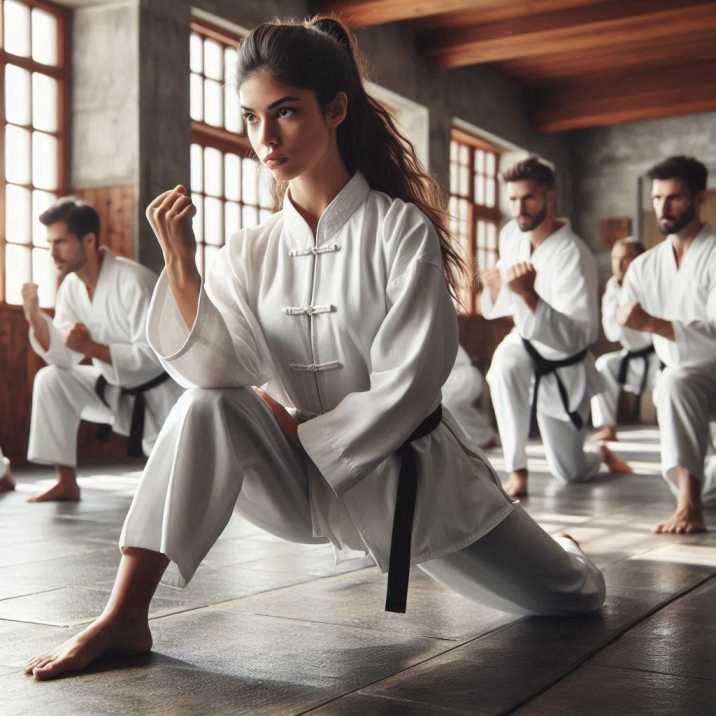Introduction
Table of Contents
Kung Fu, an ancient Chinese martial art, is not just about fighting; it’s a way of life that promotes physical and mental well-being. One of the key components of Kung Fu is the practice of forms, also known as kata. These forms are sequences of movements that simulate combat against imaginary opponents. Practicing Kung Fu forms is essential for developing technique and self-discipline. In this article, we will explore the importance of forms in Kung Fu and how they contribute to a martial artist’s growth.
What Are Kung Fu Forms?
Kung Fu forms, or kata, are predetermined sequences of movements and techniques. These movements are practiced solo and are designed to mimic real combat situations. Forms can include punches, kicks, blocks, and stances, all performed in a precise order. They serve as a foundation for learning the art of Kung Fu, allowing practitioners to internalize techniques and improve their skills.

History of Forms
The practice of forms dates back thousands of years and is deeply rooted in Chinese martial arts tradition. Forms were originally created to preserve the techniques and philosophies of different Kung Fu styles, ensuring that they could be passed down through generations.
Purpose of Forms
The primary purpose of forms is to provide a structured way to practice and refine techniques. They help practitioners develop muscle memory, improve their understanding of movement and positioning, and prepare them for real-life combat scenarios.
Importance of Practicing Forms
Developing Technique
Mastery of Movements
Practicing forms regularly allows students to master the fundamental movements of Kung Fu. Each form is designed to teach specific techniques, such as striking, blocking, and footwork. By repeating these movements, practitioners develop precision and control, which are crucial for effective self-defense.
Building Muscle Memory
Muscle memory is the ability to perform movements automatically, without conscious thought. Through consistent practice of forms, Kung Fu students develop muscle memory, enabling them to react quickly and efficiently in a real fight. This automatic response is essential for executing techniques under pressure.
Enhancing Flexibility and Strength
Forms involve a wide range of motions that require flexibility and strength. Practicing these movements helps improve overall physical fitness, making the body more agile and powerful. This physical conditioning is vital for performing advanced techniques and maintaining endurance during training and combat.
Enhancing Self-Discipline
Mental Focus
Practicing forms requires intense concentration and mental focus. Each movement must be performed with precision and intention. This focus helps practitioners develop a clear and calm mind, which is essential for making quick decisions and staying composed in stressful situations.
Consistency and Routine
The disciplined practice of forms fosters a sense of routine and consistency. Kung Fu students learn the importance of regular training and dedication to their craft. This consistency not only improves their martial arts skills but also instills a strong work ethic that can be applied to other areas of life.
Respect for Tradition
Forms are a link to the rich history and tradition of Kung Fu. By practicing forms, students show respect for the art and its origins. This respect cultivates a deeper appreciation for the discipline and encourages a lifelong commitment to learning and growth.
Additional Benefits of Practicing Forms
Stress Relief
The focused practice of forms can be a great way to relieve stress. The rhythmic and repetitive nature of the movements allows practitioners to enter a meditative state, helping to clear the mind and reduce anxiety.

Improved Balance and Coordination
Forms require precise movements and stances, which help improve balance and coordination. This is particularly beneficial for young practitioners and older adults, as it enhances their overall physical stability.
Cardiovascular Health
Practicing forms can also provide a good cardiovascular workout. The continuous flow of movements increases heart rate, improves circulation, and contributes to overall cardiovascular health.
Artistic Expression
Forms are not just about technique; they also allow for artistic expression. Each movement can be performed with a unique style and flair, reflecting the practitioner’s personality and interpretation of the form.
Community and Camaraderie
Practicing forms often takes place in a group setting, fostering a sense of community and camaraderie among practitioners. This social aspect can be motivating and provides a support system for continued growth and learning.
Common Challenges in Practicing Forms
Memorizing the Sequence
One of the main challenges students face is memorizing the sequence of movements in a form. This requires patience and repetition. Breaking down the form into smaller sections can help make the learning process more manageable.
Maintaining Consistency
Consistency in practice is crucial but can be difficult to maintain. Setting a regular training schedule and sticking to it helps build discipline and ensures steady progress.
Understanding the Application
While practicing forms, it’s important to understand the practical application of each movement. This requires guidance from a skilled instructor who can explain the purpose and context of the techniques.
Physical Limitations
Some forms may include movements that are physically challenging, especially for beginners. It’s important to progress at your own pace and focus on improving gradually to avoid injury.
Historical and Cultural Significance
Preservation of Martial Arts Heritage
Forms play a crucial role in preserving the heritage of Kung Fu. They encapsulate the techniques, strategies, and philosophies of ancient martial artists, ensuring that their knowledge is not lost over time. This preservation is important for maintaining the integrity and authenticity of Kung Fu as it is passed down through generations.
Cultural Identity
Kung Fu forms are a symbol of Chinese cultural identity. They are an integral part of traditional festivals, demonstrations, and ceremonies. Practicing forms helps practitioners connect with their cultural roots and fosters a sense of pride in their heritage.
Influence on Other Martial Arts
The practice of forms in Kung Fu has influenced many other martial arts around the world. Styles such as Karate and Taekwondo also incorporate forms, highlighting the global impact of this practice. Understanding the historical significance of forms can deepen a practitioner’s appreciation for the interconnectedness of different martial arts traditions.
Modern Applications of Forms
Competitive Sports
In modern times, forms are often performed in martial arts competitions. These performances are judged based on precision, fluidity, and power. Competing in forms can help practitioners refine their techniques and gain recognition for their skills.
Fitness and Wellness Programs
Forms are increasingly being incorporated into fitness and wellness programs. Their combination of physical exercise and mental focus makes them an excellent practice for overall health. Many gyms and wellness centers offer classes that teach simplified versions of Kung Fu forms for fitness enthusiasts.
Self-Defense Training
While forms are traditionally practiced solo, the techniques they teach are applicable in self-defense situations. Modern self-defense training programs often incorporate forms to help students develop the skills and reflexes needed to protect themselves effectively.
Table of Information
| Section | Content Summary |
|---|---|
| Introduction | Overview of Kung Fu and the role of forms in it. |
| What Are Kung Fu Forms? | Explanation of forms and their purpose. |
| Importance of Practicing Forms | Benefits of forms in improving technique and self-discipline. |
| Developing Technique | How forms help in mastering techniques. |
| Enhancing Self-Discipline | Role of forms in fostering discipline and mental strength. |
| Additional Benefits | Other advantages of practicing forms. |
| Common Challenges | Challenges faced in practicing forms and how to overcome them. |
| Historical and Cultural Significance | The historical and cultural importance of forms in Kung Fu. |
| Modern Applications of Forms | How forms are applied in contemporary martial arts training. |
| FAQs | Common questions about Kung Fu forms. |
Conclusion
Practicing forms in Kung Fu is vital for developing technique and self-discipline. These structured movements not only enhance physical abilities but also foster mental focus and respect for tradition. By understanding and appreciating the role of forms, practitioners can unlock their full potential and embrace the true essence of Kung Fu. The benefits of practicing forms extend beyond martial arts, contributing to overall physical fitness, mental clarity, and a deeper connection to cultural heritage. Whether you are a beginner or a seasoned practitioner, the journey of mastering forms is a rewarding path to personal growth and self-improvement.
FAQs
What is the main purpose of practicing Kung Fu forms?
The main purpose is to develop technique, build muscle memory, and enhance self-discipline. Forms provide a structured way to practice and refine movements.
How often should I practice Kung Fu forms?
It’s recommended to practice forms daily or at least several times a week. Consistent practice is key to mastering techniques and improving overall performance.
Can practicing forms alone improve my fighting skills?
While forms are essential for developing techniques, sparring and application drills are also necessary to apply what you’ve learned in real combat situations.
Are forms the same in all styles of Kung Fu?
No, different styles of Kung Fu have their own unique forms. Each form reflects the specific techniques and philosophies of that style.
How long does it take to learn a Kung Fu form?
The time it takes to learn a form varies depending on its complexity and the student’s dedication. It can take weeks to months to learn a basic form and years to master it.


